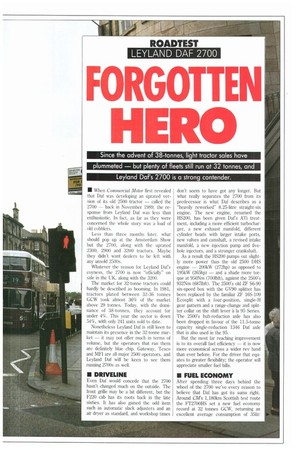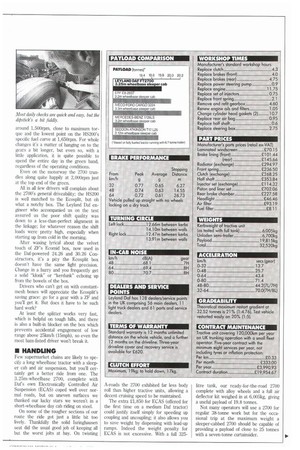FORGOTTEN FIERO
Page 27

Page 28

Page 29

If you've noticed an error in this article please click here to report it so we can fix it.
• When Commercial Motor first revealed that Daf was developing an uprated version of its old 25(() tractor — called the 2700 — back in November 1989, the response from Leyland Daf was less than enthusiastic. In fact, as far as they were concerned the whole story was a load of old cobblers.
Less than three months later, what should pop up at the Amsterdam Show but the 2700, along with the uprated 2300, 2900 and 3200 tractors. Maybe they didn't want dealers to be left with any unsold 2500s.
Whatever the reason for Leyland Dafs coyness, the 2700 is now "officially" on sale in the UK, along with the 32(X).
The market for 32-tonne tractors could hardly be described as booming. In 1981, tractors plated between 32-36 tonnes GCW took almost 36% of the market above 29 tonnes. Today, with the dominance of 38-tonnes, they account for under 4%. This year the sector is down 54%, with only 241 units sold to date.
Nonetheless Leyland Daf is still keen to maintain its presence in the 32-tonne market — it may not offer much in terms of volume, but the operators that run them are definitely blue chip. Gateway, Tesco and MEI are all major 2500 operators, and Leyland Daf will be keen to see them running 2700s as well.
• DRWELINE
Even Daf would concede that the 2700 hasn't changed much on the outside. The front grille may be a bit different, but the F220 cab has its roots back in the late sixties. It has also gained the odd item such as automatic slack adjusters and an air dryer as standard, and workshop times don't seem to have got any longer. But what really separates the 2700 from its predecessor is what Daf describes as a "heavily reworked" 8.25-litre straight-six engine. The new engine, renamed the HS200, has been given Dafs ATi treatment, including a more efficient turbocharger, a new exhaust manifold, different cylinder heads with larger intake ports, new valves and camshaft, a revised intake manifold, a new injection pump and fivehole injectors, and a stronger crankshaft.
As a result the HS200 pumps out slightly more power than the old 2500 DHS engine — 2(X)kW (272hp) as opposed to 195kW (265hp) — and a shade more torque at 950Nm (7001bft), against the 2500's 932Nm (6871bft). The 2500's old ZF 56-90 six-speed box with the GV90 splitter has been replaced by the familiar 'LP' 16S-109 Ecosplit with a four-position, single-H gear pattern and a range-change and splitter collar on the shift lever a la 95 Series. The 2500's hub-reduction axle has also been dropped in favour of the 11.5-tonne capacity single-reduction 1346 Daf axle that is also used in the 95.
But the most far reaching improvement is to its overall fuel efficiency — it is now more economical across a wider rev band than ever before. For the driver that equates to greater flexibility; the operator will appreciate smaller fuel bills.
• FUEL ECONOMY
After spending three days behind the wheel of the 2700 we've every reason to believe that Daf has got its sums right. Around CMs 1,180km Scottish test route the FT2700HS set a new fuel economy record at 32 tonnes GCW, returning an excellent average consumption of 351it1
100km (8.07mpg). The plucky little 2700 now joins the select band of tractors that have gone around our test route with either a box or curtainsided trailer and broken the magic 35.31it/1001cm (8.0mpg) barrier. In fact, the only other 32-tonner to do it is the Cummins L10-powered lyeco Ford 3224 Cargo, which was a fraction behind with 34.141it/100km (8.04mpg), when we tested it five years ago.
When it comes to comparing the 2700 against other 32-tonne tractors we're a bit short of contenders. As the tractor market has polarised towards 38 tonnes, the number of 32-tonners coming forward for test from the manufacturers has slowed from a steady stream to a sporadic drip.
The last one we tested — the C Series engined ERF E8.26ST — was almost two years ago, and in any case it has been superseded by the E8 with the uprated 205kW (275hp) C Series. Even so, our comparison charts show well enough how it rates against other typical high street distribution tractors.
If we were judging the 2700 on fuel economy alone its performance would be impressive. What takes its consumption into another league is the time it took to do it. Its overall average speed of Daf s 8.25-litre HS200 engine gets the ATI treatment and added noise suppression material. Rear cab mounts have also been improved, now including two stabiliser rods and coil springs and dampers. 70.471cm/h (43.8mph) is head and shoulders above the opposition, and well up with many more powerful 38-tonners.
Regardless of the terrain from tough motorways and severe gradients to easy A-roads, the 2700 gets down to work fast. Compared with the old 2500 tested back in 1983, the 2700 is not only 8% more fuel efficient, but also faster by almost 51tm/h (3mph).
• PERFORMANCE
Peak torque is delivered at a relatively high 1,500rpm, and the HS200 engine is at its best at around this speed.
Our 2700 climbed up Shap in 8L with bulldog tenacity; its tachometer needle rock steady on 1,500rpm at the start of the solid green economy band. Such is the 2700's relish for hard graft that on many hills we'd pre-select a half gear only to find we didn't need it. On the more severe sections of the A68, not surprisingly, the HS200 did need some extra revs.
On the level the 2700 will invariably pull away quite happily in 2H, skipping to 414 then 5H and 6H before you need to think about splitting gears.
Splitting at around 1,750-1, 800rpm inevitably puts the rev needle back down
around 1,500rpm, close to maximum torque and the lowest point on the HS200's specific fuel curve at 1,650rpm. For whole changes it's a matter of hanging on to the gears a bit longer, but even so, with a little application, it is quite possible to spend the entire day in the green band, regardless of the operating conditions.
Even on the motorway the 2700 trundles along quite happily at 2,000rpm just at the top end of the green.
All in all few drivers will complain about the 2700's general driveability; the HS200 is well matched to the Ecosplit, but oh what a notchy box. The Leyland Daf engineer who accompanied us on the test assured us the poor shift quality was down to a less-than-perfect alignment in the linkage; for whatever reason the shift loads were pretty high, especially when starting up from cold in the morning.
After waxing lyrical about the velvet touch of ZF's Ecomid box, now used in the Dal-powered 24.26 and 30.26 Constructors, it's a pity the Ecosplit box doesn't have the same light precision. Change in a hurry and you frequently get a solid "klonk" or "kerdunk" echoing up from the bowels of the box.
Drivers who can't get on with constantmesh boxes will appreciate the Ecosplit's saving grace: go for a gear with a ZF and you'll get it. But does it have to be such hard work?
At least the splitter works very fast, which is helpful on tough hills, and there is also a built-in blocker on the box which prevents accidental engagement of low range above 25km/h (15mph), so even the most ham-fisted driver won't break it.
• HANDLING
Few supermarket chains are likely to specify a long wheelbase tractor with a sleeper cab and air suspension, but you'll certainly get a better ride from one. The 3.25m-wheelbase 2700, complete with Dais own Electronically Controlled Air Suspension (ECAS) coped well over normal roads, but on uneven surfaces we thanked our lucky stars we weren't in a short-wheelbase day cab riding on steel.
On some of the rougher sections of our route the ride got just a little bit too lively. Thankfully the solid Isringhausen seat did the usual good job of keeping all but the worst jolts at bay. On twisting A-roads the 2700 exhibited far less body roll than higher tractive units, allowing a decent cruising speed to be maintained.
The extra £1,850 for ECAS (offered for the first time on a medium Daf tractor) could justify itself simply for speeding up coupling and uncoupling; it also allows you to save weight by dispensing with lead-up ramps. Indeed the weight penalty for ECAS is not excessive. With a full 325 litre tank, our ready-for-the-road 2700 complete with alloy wheels and a full air deflector kit weighed in at 6,005kg, giving a useful payload of 19.8 tonnes.
Not many operators will use a 2700 for regular 38-tonne work but for the occasional trip at the maximum weight a sleeper-cabbed 2700 should be capable of providing a payload of close to 25 tonnes with a seven-tonne curtainsider.




































































